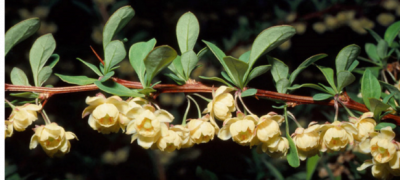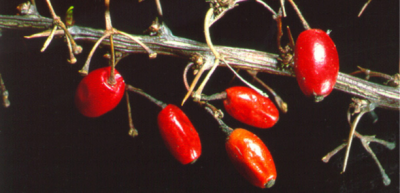Berberis thunbergii
By Victoria Wallace, Alyssa Siegel-Miles, and Klaudia Sowizral, UConn Extension
Identifying Features
- OVERVIEW: Deciduous shrub. Typically 2-3 ft. tall, but can grow up to 6 ft. Slightly wider than tall. Grows in dense thickets with arching branches. Zone 4-8.
- LEAVES: Alternate, small (up to an inch long). Ovate (egg-shaped), simple, and entire (smooth edges); grow in clusters. Leaf tip is wider than the base. Bright green in spring and summer; turning maroon, purple, or red in autumn. Cultivars include yellow, red, and purple foliage spring through fall. In native woodland understories, it is highly conspicuous, as leaves and flowers emerge much earlier in spring and foliage remains longer into fall than most native species.
- STEMS: Very twiggy and deeply grooved, with multiple thin woody stems branching out from one point in the ground. A single, sharp, long spine is evident at each leaf node. Bark turns reddish-brown in winter; with yellow inner bark.
- FLOWERS: Small, dangling yellow flowers in clusters of 2-4 at nodes in April to May, profuse along the entire length of the stem. Insect-pollinated.
- ROOTS: Yellow, fibrous, and shallow; with rhizomes (under-ground reproductive stems).
- FRUIT: Many hard, elliptical, bright red drupes produced late summer through October; often persist into winter after leaves have been shed.
- REPRODUCTION/SPREAD: Seeds dispersed by birds and small mammals; however, most seeds fall close to the parent plant. Seeds germinate in spring, with germination rates estimated to be as high as 90% (mdinvasives.org). Clonal shoots from rhizomes sprout below ground, and tips of branches can root when they touch the ground.
- Associated with the spread of Lyme disease. Higher densities of rodent hosts and deer ticks prefer to shelter under barberry than under native shrubs. When populations of barberry are controlled, fewer mice and ticks are present.
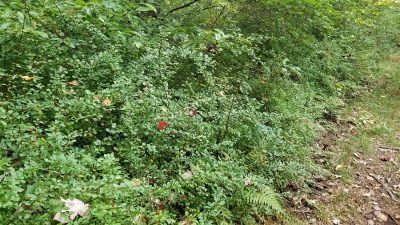
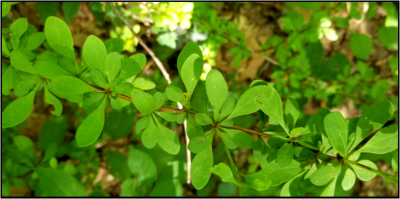
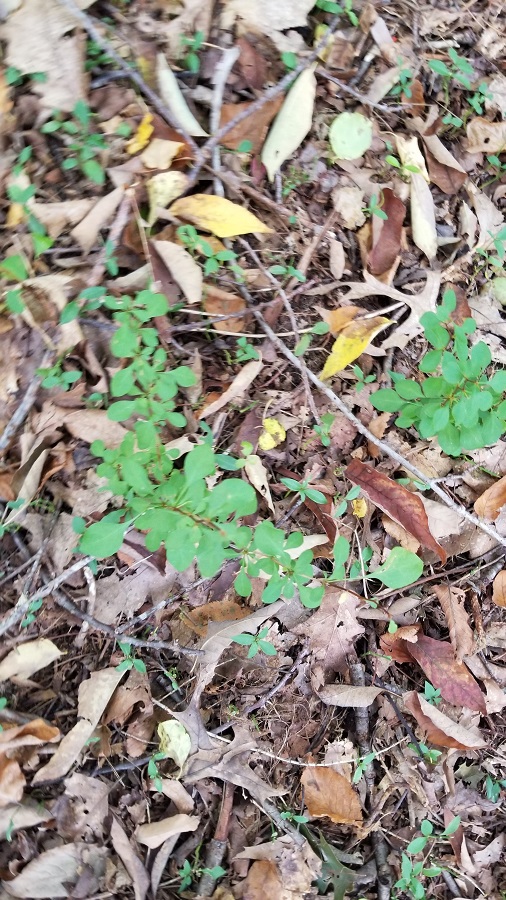
Habitat
Japanese barberry is very adaptable and can tolerate a variety of conditions, including drought. Prefers well-drained soils in semi-shade, but also common to sunny areas. Dense populations are found in open fields and meadows, pastures, and roadsides. Barberry frequently escapes into woodlands, forest edges, early successional forest, forested wetlands, and stream banks, disturbing native habitats and threatening our native flora and fauna. Resistant to deer browsing. When deer numbers are high, native plant populations are decimated, while barberry thrives.
Dense populations of barberry are found in woodlands, open fields and meadows, pastures, and roadsides. Photo by Alyssa Siegel-Miles.
Control
For best results, integrate an early-season initial treatment (e.g., mechanical or directed burning) with a mid-season follow-up treatment (e.g., directed burning or herbicide application). Plants growing in full sun produce more seeds than those in shade, so their control should be prioritized. Japanese Barberry Control Methods (Ward, Williams, and Worthley) provides greater details.
MECHANICAL: May be sufficient to eradicate small infestations; for established stands, mechanical controls may be used in conjunction with chemical controls or directed burning. Mechanical control efforts should be concentrated in the early spring, while desirable native species are still dormant, and late fall - foliage remains later in the season than many other species.
Pulling/digging: Roots are shallow. Removal of seedlings and small plants is efficient. Tools (e.g., Extractigators, weed wrenches) can help facilitate removal of larger plants. Root crowns must be removed in order to prevent resprouting. Removal is easiest when the soil is moist. Minimize soil disturbance; tamp down soil after completion. Thick gloves and long canvas sleeves are recommended for protection from the plant’s sharp spines.
Cutting/mowing: Repeated cutting will limit barberry’s spread, but resprouting will occur from the root crown. Resprouts can be treated with herbicide or burned with a propane torch for greater efficacy.
DIRECTED BURNING: A propane torch can be used effectively. Burn the base of stems near the ground to kill the tissues that transport nutrients and water to the rest of the plant. For large specimens, it is recommended to remove top growth to make the base of the stems accessible and/or to allow the plants to re-sprout to deplete their root reserves before burning (e.g., plants cut in July; burned in November of the same year). For more details, visit Berberis thunbergii (Fire Effects Information System). Where pesticide use is restricted, mechanical removal followed by burning of resprouts is likely the most effective strategy.
CHEMICAL: Follow label instructions for all applications.
Foliar sprays (e.g., glyphosate; triclopyr) are recommended for large infestations. Effective from one month after leaf expansion until autumn. Fall treatment, after other plants’ foliage falls, helps minimize damage to desirable plants.
Cut-stem treatments: Cutting stems and then chemically painting the cut stems is effective, although very labor intensive; preferred for smaller infestations and to minimize damage to understory natives. Cut-stump treatment can be done in any season, except in early spring, when plant sap is flowing upwards from roots to sprouts/stems.
Barberry plants treated with any herbicide should be monitored for at least a year, as they may resprout. Refer to Michigan Dept. of Natural Resources for more details.
Distribution
Japanese Barberry is found in the Northeastern U.S., as well as northern states in the Midwest. Invasive in all New England states. Populations extend from Maine to North Carolina, and west to Minnesota.
Background and Native Alternatives
Japanese barberry originated from Japan and was brought to the U.S. as an ornamental in the late 1800s. Planting seed-bearing Japanese barberry is not recommended, to prevent seed production and dispersal. Seedless cultivars have recently become commercially available. Common winterberry (Ilex verticillata) and highbush blueberry (Vaccinium corymbosum) are recommended native alternatives.
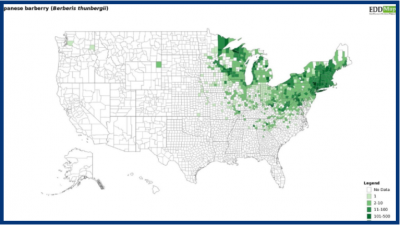
SOURCES:
- BugwoodWiki. (Updated 2014, August 19). Berberis thunbergii/NJ. https://wiki.bugwood.org/Berberis_thunbergii/NJ#Flowers
- Connecticut Invasive Plants Council. (2018, October). Connecticut Invasive Plant List. https://cipwg.uconn.edu/wp-content/uploads/sites/244/2023/04/CT-Invasive-Plant-List-2018_Scientific-Name.pdf
- Maine Natural Areas Program. (n.d.) Maine Invasive Plants Bulletin #2504: Japanese Barberry. University of Maine Cooperative Extension. https://extension.umaine.edu/publications/wp-content/uploads/sites/52/2015/04/2504.pdf
- Michigan Department of Natural Resources. (2012, February). Invasive Species - Best Control Practices: Japanese Barberry. https://mnfi.anr.msu.edu/invasive-species/JapaneseBarberryBCP.pdf
- National Park Service & U.S. Fish and Wildlife Service. (2010). Japanese Barberry. In Plant Invaders of Mid-Atlantic Natural Areas, 4th ed. https://www.invasive.org/alien/pubs/midatlantic/beth.htm
- Varricchio, E. & Connecticut Invasive Plant Working Group. (n.d.). Connecticut’s Invasive Plant Management Calendar: The Top 10 Invasive Plants [PowerPoint slides]. Connecticut Invasive Plant Working Group. https://cipwg.uconn.edu/wp-content/uploads/sites/244/2018/10/Invasive-Plant-Management-Calendar.pdf
Questions? Contact:
Vickie Wallace
UConn Extension
Extension Educator
Sustainable Turf and Landscape
Phone: (860) 885-2826
Email: victoria.wallace@uconn.edu
Web: ipm.uconn.edu/school
UConn Extension is committed to providing equal access and full participation for individuals with disabilities within all our programs and activities. Visit s.uconn.edu/accessibility for more resources. UConn is an equal opportunity program provider and employer.
Funds to support the creation of this document were provided by the Crop Protection and Pest Management Extension Implementation Program [grant no. 2017-70006-27201/project accession no. 1013777] from the USDA National Institute of Food and Agriculture.
©UConn Extension. All rights reserved.
Updated May 2021
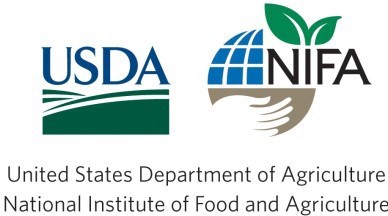  |
